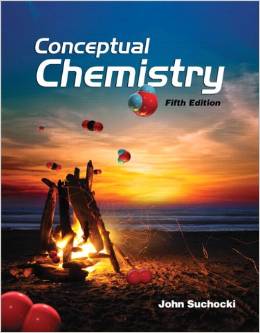Conceptual Chemistry seems daunting at first glance. This 575-page book weighs more than three pounds. But as I started reading it, I was amazed to find myself really engrossed in it because I was learning about new developments in chemistry and their practical application. A quick look at the brief table of contents (p. v) gives the impression that this is like most science texts with its chapter headings: “About Science,” “Particles of Matter,” “Elements of Chemistry,” Subatomic Particles,” and so on. But the full table of contents (beginning on p. vi) gives you a hint that this text might be different since every chapter begins with a simple hands-on chemistry experiment or activity like “The Quantized Whistle” or “Circular Rainbows,” and every chapter concludes with a Contextual Chemistry article on a very practical topic such as “Global Climate Change,” “Extending the Human Life Span,” and “Fracking for Shale Gas.”
However, it’s not only the beginning and ending parts of each chapter that are interesting. The lesson material in between is presented quite differently from other textbooks. Author John Suchocki aims to provide practical chemistry knowledge for the liberal arts major in college that will be useful in life, but he also wants to help students become better thinkers in general. Consequently, Conceptual Chemistry stresses concepts and applications of chemistry, sometimes in a storytelling fashion. Conceptual understanding is so important to Suchocki that he includes “Concept Checks” every few pages with questions like “Does technology come from science or does science come from technology?” (p. 10). Answers follow immediately afterward, but the Concept Checks challenge students to stop and apply some critical thinking to what they have been reading. The text is loaded with purposeful full-color illustrations that often add information that furthers a student’s understanding of a concept.
Conceptual Chemistry teaches chemistry by continually making connections to modern technology, current events, and personal applications. Suchocki often integrates concepts from chemistry with other scientific disciplines.
At the end of each chapter are quite a few questions grouped under different headings: “Reading Check Questions” (comprehension), “Confirm the Chemistry” (one or more hands-on activities with questions), “Think and Solve” (questions requiring some math calculations), “Think and Compare” (analytical questions), “Think and Explain” (questions that require students to synthesize information), “Think and Discuss” (questions that require evaluation), and “Readiness Assurance Test/RAT” (a 10-question quiz). Answers to the odd-numbered questions (all except the RATs) are at the back of the textbook. Answers to RATs are online at conceptualchemistry.com.
While less math is required by the text than by other college-level chemistry texts, students still need to know fractions, percentages, and basic algebra. Most chapters include a “Calculation Corner” section that teaches a math application, often in the context of a particular situation. A few questions follow. Answers for Calculation Corners are at the end of the chapter. Even though the math is less intensive, this is still a challenging chemistry course.
The textbook is available in hardcover or as an ebook. The ebook can be rented or purchased.
Learn Science Conceptual Academy Courses
Conceptual Chemistry shares publishers with Conceptual Physics, the first book published in this series, although they have different authors. Both books were written for college students but will work for high schools students as well. The texts are published by Savvas Learning for use in classrooms. Consequently, teacher manuals and other ancillary resources are expensive. The authors of the “Conceptual” series textbooks have joined together to create Learn Science Conceptual Academy for homeschoolers where they provide self-study courses that can be accessed for a subscription fee. Check out that review to learn about four different course options for Conceptual Chemistry.
Summary
Homeschoolers can use the Conceptual Chemistry textbook on its own since there are answers to enough of the chapter questions as well as the RATs for parents to assess their knowledge. However, there are no cumulative exams with this option unless you invest in the pricey ancillary resources.
I think the self-study courses make the most sense for homeschoolers since students benefit from video instruction all of the ancillary resources. I also love Learn Science Conceptual Academy's options for tailoring a chemistry course to suit the student's interests rather than having every student complete the identical course. In addition, parents should appreciate that they do not have to buy a separate teacher's manual or tests.
Either way, Conceptual Chemistry is a great choice for homeschoolers who want serious chemistry coverage that is up to date.










